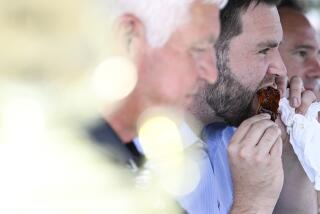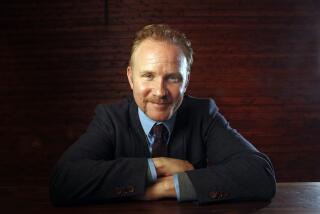A short history of extreme dining
- Share via
Imperialist Romans, according to the contemporary gourmand Apicius, adored their feasts of stuffed sow’s womb and honeyed wine, sometimes followed by purging to make room for more. In our overabundant times, it’s the opposite: We’re obsessed with cutting back calories, fats, entire food groups -- or eliminating food altogether. Below, some memorable moments in zealous eating and not-eating.
500 BC: The ancient Greeks developed the ascetic vegetarian diet and were generally restrained eaters, but in 480 BC, a winning Olympic athlete prepared with a 10-month meat-only diet.
AD 69: The rich and powerful of Rome reinforced their stature with lavish banquets. The emperor Vitellius’ dinner featured 2,000 of the most costly fish and 7,000 birds. His favorite dish included pheasant and peacock brains and flamingo tongues.
1570: Bartolomeo Scappi, a famous Renaissance chef, wrote “Opera,” a six-part cookbook with 1,000 recipes he prepared for popes. In addition to banishing Jews to the ghetto, the gluttonous Pius V enjoyed pig’s blood omelet, boneless frog soup and barbecued bear.
1960s: Ann Wigmore, a Lithuanian immigrant to Boston, started the living food diet, a.k.a., the raw food diet (eating natural food in an uncooked state). Some 30 years later, Woody Harrelson sings the diet’s praises and Jamba Juice serves wheat grass to soccer moms. The boundaries of the raw food fad continue to narrow, however. The latest controversy: carrots and a few other vegetables are considered too “hybridized” (genetically modified) for purists.
1980s: The breatharians promoted a diet they say takes nutrients from the air. In 2000, Australian guru Jasmuheen told the BBC that she lived on less than 300 calories a day. Wiley Brooks, the founder of the Breatharian Institute of America, claims something similar -- despite a penchant for McDonald’s cheeseburgers and Diet Coke (something to do with “the base frequency of liquid light,” says his website).
1990s: Eight scientists entered Biosphere 2, a self-contained greenhouse in Arizona, and realized they were short on food. Scientist Roy Walford put his longevity diet to the test: For two years, the group lived on vegetables, goat milk and a weekly meat serving. The UCLA pathologist died at 79 in 2004 of Lou Gehrig’s disease but interest in his diet/lifestyle (which recommends cutting caloric intake by 25%) continues. Daughter Lisa describes a typical breakfast in her book, “The Longevity Diet”: four walnuts, six almonds, 10 peanuts.
-- Margaret Wappler
More to Read
Eat your way across L.A.
Get our weekly Tasting Notes newsletter for reviews, news and more.
You may occasionally receive promotional content from the Los Angeles Times.










